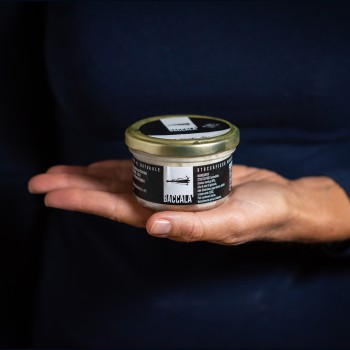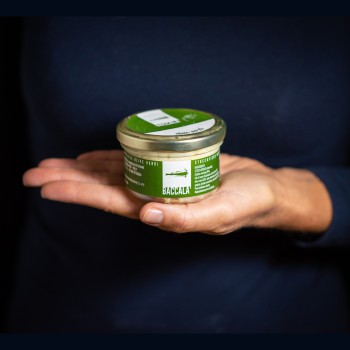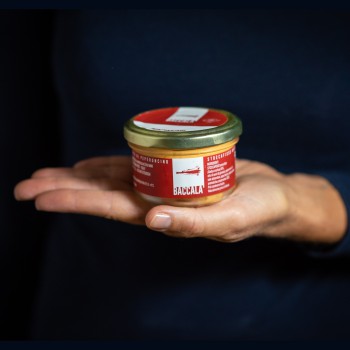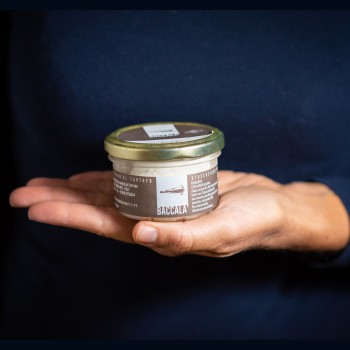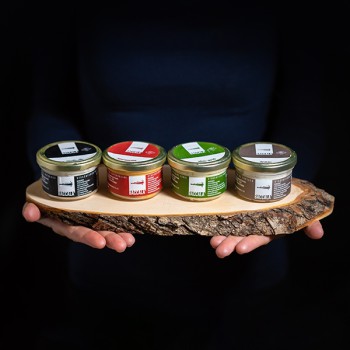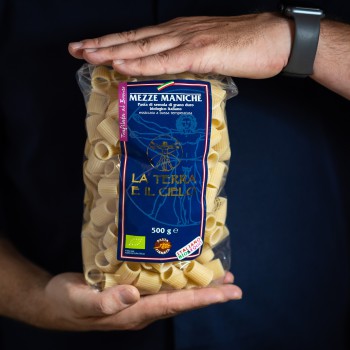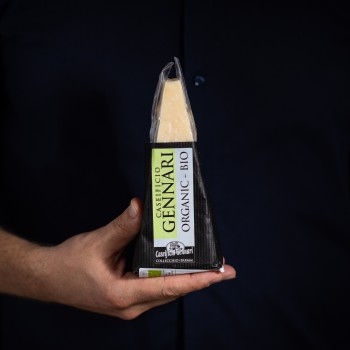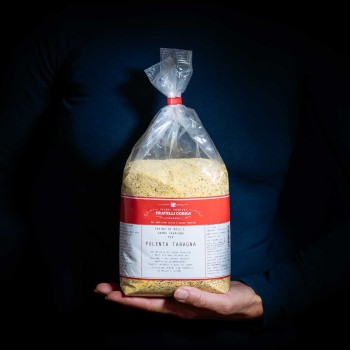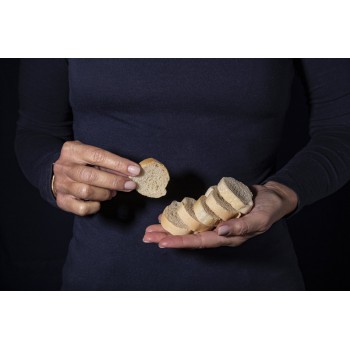- Meat & Seafood add remove
- Cured meats & Cheeses add remove
- Pasta & Pizza add remove
- Preserves & Condiments add remove
-

- Pickles & Preserves add remove
-
- Truffles, legumes & mushrooms add remove
- Desserts & snacks add remove
- Organic
- Tasting Selections
- Christmas
- Regali aziendali
- Brands
- Meat & Seafood add remove
- Cured meats & Cheeses add remove
- Pasta & Pizza add remove
- Preserves & Condiments add remove
-

- Pickles & Preserves add remove
-
- Truffles, legumes & mushrooms add remove
- Desserts & snacks add remove
- Organic
- Tasting Selections
- Christmas
- Regali aziendali
- Brands
Whipped salt cod
Whipped salt cod: the Norwegian delicacy made in Padua
Whipped salt cod spread is one of the most traditional dishes from Veneto. It is always served as cicchetti, i.e. appetisers made by bacari, the traditional inns in Venice. It tastes amazing spread on a roasted polenta slice or paired with a nice glass of wine.
Jar of whipped salt cod spread – 90g


The brands we selected
.jpg)
How is whipped salt cod spread made?
Salt cod, oil, garlic, bay leaves, lemon, salt and pepper - these are the only ingredients of whipped salt cod spread. Some people add a drop of milk to make it even creamier, but it is actually not contemplated in the original recipe.
Stockfish, which has been soaking for at least 48 hours and deboned, is steamed in cold and slightly salted water. When the fish becomes tender (that is when it starts breaking apart), it is drained and whipped with lemon, garlic and bay leaves. The oil should be added little by little, to allow the mixture to properly whip, like a mayonnaise. Finally, salt and pepper are added and the dish is served.
The traditional recipe forbids the use of blenders or other tools: salt cod should only be whipped by hand with a wooden spoon. Let’s be honest; we all know that a stand blender is your best friend in the kitchen, but you do obtain a different consistency if you whip it with a blender. The spread is just not the same and if you want the traditional whipped salt cod spread, you have to roll up your sleeves and let your muscles do the work.
Whipped salt cod is foamy and spreadable; it is not an actual spread, but it is very close to it - it’s like a flavourful cloud. It should be whipped for the right amount of time to make it soft, but it should not be overdone; it should be smooth and velvety and not sticky to the palate.
As far as the size of chunks is concerned, it all depends on your personal taste. Some people like to leave in bigger chunks; other people prefer a completely smooth spread. It is an exceptional dish no matter what.
Salt cod or stockfish?
Let’s deal with the terminology issue straight away.
Stockfish: this word comes from Scandinavian and Germanic languages, from stock (which means stick) and fish or vish.
Baccalà or Salt cod: this word originated in romance languages, such as for instance bacalhau in Portuguese. It comes from the Latin word baculus which means stick.
Stockfish and Baccalà refer to two different ways to cook cod. In the case of stockfish, the fish is dried outside under the sun and in the wind and is left for three months on the racks. On the contrary, Baccalà is salted for three weeks.
Whipped salt cod spread is actually made with stockfish. It is a little bit confusing, since when stockfish first landed in Italy, people were already accustomed to using the world “baccalà” and did not find a different term for it, even though they are not the same thing.
The story of a delicacy coming from afar
In Venice it is regarded as the king of appetisers, but this dish did not see the light of day in the Venetian Lagoon. Its place of origin is located further to the North. But let’s go in order.
It was the year 1432. The Venetian merchant Pietro Querini sailed off in a merchant vessel to do some business in the Flanders but due to a storm, he was left stranded in the Lofoten islands, in the southernmost island of the Norwegian archipelago called Røst, to be more precise.
Once he recovered, Querini started to observe the habits and customs of the people and immediately noticed that their diet mainly consisted of one type of fish. Well, there isn’t a wide fish variety once you pass the Arctic Circle anyway, but the Venetian merchant was actually right.
Querini wrote down that these fishes, called “stocfisi”, were dried out in the wind and under the sun, without using any salt. The meat hardens, since it dehydrates completely; as a matter of fact, it loses around 70% of its weight and becomes as hard as a stick - hence the name.
Whenever they wanted to eat it, Norwegian fishers had to beat the fish up with a wooden oar, in order to break it into pieces which were then shredded and served with butter and spices. That’s the origin of whipped salt cod spread; we could say that the whole process is slightly more sophisticated now and Venetian innkeepers do not carry an oar around with them, but the idea behind it is the same.
Querini is talking about the Atlantic cod (Gadus Morhua) here, which can measure up to two metres in length and weigh as much as 90kg. The traditional processing method is still the same; nowadays, in the Lofoten islands, the freshly caught fish is cleaned, decapitated, sliced in two and put on special racks to dry out.
Querini sailed back to Venice with a cargo hold filled with dried fish. Stockfish did not meet with instant success, though, also because people in the lagoon did not feel the need to try out yet another fish.
However, it has one big advantage: it lasts for months and that’s why it became the favourite food of seafarers. It is super nutritious, it is easy to transport and it is not perishable - it is the ideal food to carry in long-haul boat trips.
This dish was officially recognised only over a century later. The Council of Trent, which was summoned as a response to the diffusion of the Protestant reformation in Europe, ended in 1563, 18 years after the first assembly was held. In this instance, it was officially forbidden to eat meat for 200 days, including Fridays, the eves of holy days and Lent.
Therefore, meatless dishes gained in popularity. There were many meatless days and even more worshippers and not everyone could afford fresh fish. That’s how salt cod became the ideal food for the poorest worshippers.
Bartolomeo Scappi (1500-1577) - Pius V’s cook - published the most important essay on cuisine of his time and, among more than a thousand recipes, there is also the recipe of whipped salt cod, which was the ultimate recognition of this dish.
Pellegrino Artusi in his work “Science in the kitchen and the art of eating well” in 1891 states the following: “[…] salted codfish, when prepared in this fashion, loses its vulgar nature, becoming very delicate and worthy of gracing an elegant table, either as an appetizer or entremets.”
Whipped salt cold has come a long way: from basic foodstuff of Nordic people, through meatless dish for the masses, to a delicacy for noble people.
Gastronomia Marcolin delicatessen was first opened in 1985 and it launched the Baccalà product assortment: classic whipped salt cod, with olives, with truffles or with red hot chilli pepper - four delicacies to spread on bread or on polenta slices. Only the best Atlantic cod is used to make these products according to the traditional recipe.
If you want to try out the best whipped salt cod out there, keep this name in mind. These little jars are packed with this flavourful fish, as well as with the history of its legendary recipe.






















